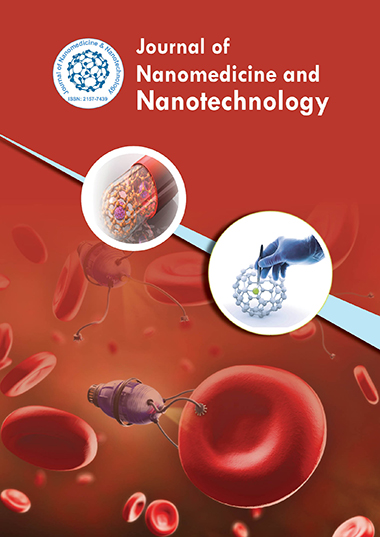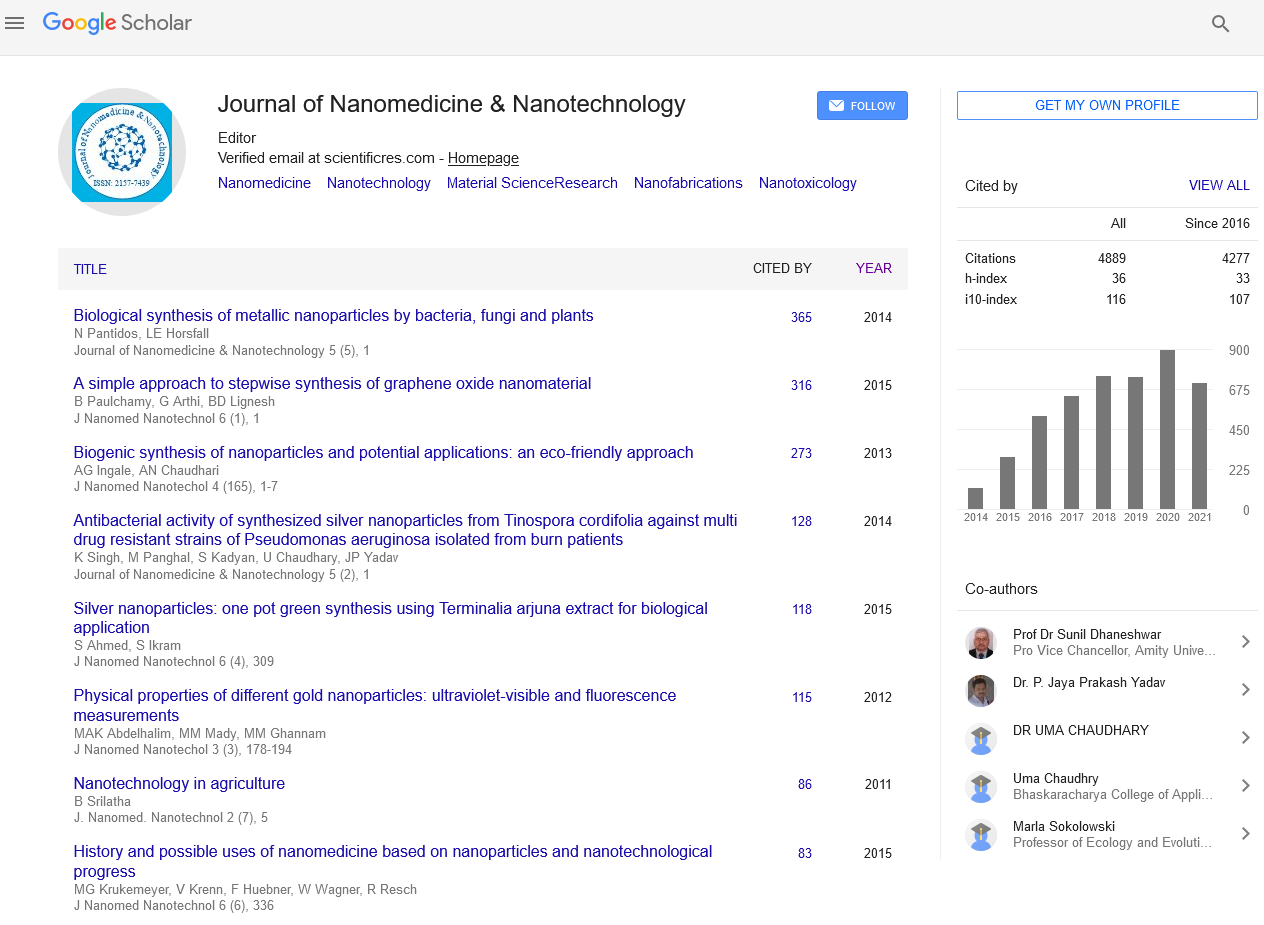Indexed In
- Open J Gate
- Genamics JournalSeek
- Academic Keys
- JournalTOCs
- ResearchBible
- China National Knowledge Infrastructure (CNKI)
- Scimago
- Ulrich's Periodicals Directory
- Electronic Journals Library
- RefSeek
- Hamdard University
- EBSCO A-Z
- OCLC- WorldCat
- SWB online catalog
- Virtual Library of Biology (vifabio)
- Publons
- MIAR
- Scientific Indexing Services (SIS)
- Euro Pub
- Google Scholar
Useful Links
Share This Page
Journal Flyer

Open Access Journals
- Agri and Aquaculture
- Biochemistry
- Bioinformatics & Systems Biology
- Business & Management
- Chemistry
- Clinical Sciences
- Engineering
- Food & Nutrition
- General Science
- Genetics & Molecular Biology
- Immunology & Microbiology
- Medical Sciences
- Neuroscience & Psychology
- Nursing & Health Care
- Pharmaceutical Sciences
Editorial - (2025) Volume 16, Issue 1
Nanoparticle-Driven Modulation of Tumor-Associated Macrophages in Cancer Immunotherapy
Yuka Nakamura*Received: 01-Jan-2025, Manuscript No. jnmnt-25-28316; Editor assigned: 03-Jan-2025, Pre QC No. jnmnt-25-28316 (PQ); Reviewed: 16-Jan-2025, QC No. jnmnt-25-28316; Revised: 23-Jan-2025, Manuscript No. jnmnt-25-28316 (R); Published: 31-Jan-2025, DOI: 10.35248/2157-7439.24.16.770
INTRODUCTION
The immune microenvironment within tumors plays a critical role in the progression and treatment of cancer. Tumor-associated macrophages (TAMs), which are a major component of this microenvironment, have been identified as key modulators of tumor growth, metastasis, and response to therapies. In most cancers, TAMs promote immunosuppression, angiogenesis, and tissue remodeling, facilitating tumor survival and progression. Consequently, reprogramming TAMs to adopt a more tumor-suppressive phenotype has emerged as a promising strategy in cancer immunotherapy. Recent advancements in nanotechnology have provided novel tools for modulating the activity of TAMs. Nanoparticle-based approaches offer targeted, efficient, and controlled methods to influence TAM behavior, potentially enhancing the effectiveness of cancer immunotherapy. This article explores the role of TAMs in cancer, how nanoparticles can modulate TAM functions, and the potential for using nanoparticle-driven modulation in clinical applications [1].
TUMOR-ASSOCIATED MACROPHAGES ROLE IN CANCER PROGRESSION
Macrophages are key immune cells that typically reside in tissues throughout the body, where they perform various functions such as tissue homeostasis, pathogen clearance, and immune regulation. Within the tumor microenvironment, macrophages can be polarized into two major phenotypes: the pro-inflammatory M1 phenotype and the anti-inflammatory M2 phenotype. The M1 phenotype is associated with the release of pro-inflammatory cytokines and the promotion of immune responses against tumors. In contrast, M2 macrophages are generally immunosuppressive and support tumor progression by promoting angiogenesis, tissue remodeling, and immune evasion [2]. In most cancers, TAMs predominantly adopt an M2-like phenotype, which contributes to an immunosuppressive microenvironment that limits the effectiveness of both innate and adaptive immune responses. This phenotype is also associated with the secretion of cytokines and growth factors that facilitate tumor growth and metastasis. Therefore, reprogramming TAMs from an M2 to an M1 phenotype, or enhancing their anti-tumor functions, represents a critical therapeutic goal in cancer immunotherapy [3].
NANOPARTICLE-MEDIATED MODULATION OF TAMS
Nanoparticles (NPs) have demonstrated great promise as tools for modifying immune responses due to their unique size, surface area, and ability to be functionalized with various ligands. Their small size allows them to easily penetrate tissues and interact with cells, while their large surface area enables the attachment of targeting agents, drugs, or proteins that can modulate cellular activity. In the context of TAM modulation, nanoparticles can be designed to specifically target macrophages in the tumor microenvironment and deliver therapeutic payloads that alter their phenotype and function [4]. One of the primary ways nanoparticles can modulate TAMs is by delivering cytokines, small molecules, or genetic material that can promote the polarization of TAMs from the M2 to the M1 phenotype. For instance, nanoparticles can be engineered to carry immune-stimulating agents such as interferons (IFNs) or Toll-like receptor (TLR) agonists, which are known to activate M1 polarization. These agents can be encapsulated in nanoparticles that are either taken up by TAMs through endocytosis or directly targeted to TAMs using surface-functionalized ligands, such as antibodies or peptides that bind to macrophage surface receptors. Moreover, nanoparticles can be designed to release chemokines or inhibitors of immunosuppressive pathways to reprogram TAMs. For example, nanoparticles loaded with inhibitors of signaling pathways such as the PD-1/PD-L1 axis or the colony-stimulating factor 1 receptor (CSF1R) can enhance the anti-tumor response by decreasing the immunosuppressive activity of TAMs. By reducing the expression of these immunosuppressive molecules, nanoparticles can not only promote TAM reprogramming but also enhance the effectiveness of other immunotherapies, including immune checkpoint inhibitors [5].
ADVANTAGES OF NANOPARTICLE-BASED TAM MODULATION
The use of nanoparticles for TAM modulation in cancer therapy offers several advantages over traditional methods. First, nanoparticles can provide targeted delivery to the tumor microenvironment, where they can specifically interact with TAMs without affecting healthy tissues. This selective targeting reduces the risk of systemic toxicity, a common concern with conventional treatments that aim to modify immune cells. Second, nanoparticles can be engineered to release their therapeutic payloads in a controlled manner. For instance, nanoparticles can be designed to release their contents in response to changes in the tumor microenvironment, such as acidic pH or the presence of specific enzymes. This controlled release ensures that the therapeutic agents are delivered directly to TAMs in the tumor, increasing the efficiency of treatment and minimizing off-target effects [6]. Additionally, nanoparticles can be used to modulate multiple aspects of TAM function simultaneously. For example, a single nanoparticle formulation could deliver both immune-modulating agents to promote M1 polarization and agents that block immunosuppressive pathways to enhance the overall anti-tumor immune response. This ability to combine multiple therapeutic strategies in one nanoparticle platform is a major advantage, as it allows for a more comprehensive approach to targeting TAMs and improving cancer immunotherapy outcomes [7].
ENHANCING IMMUNOTHERAPY WITH NANOPARTICLE-MEDIATED TAM MODULATION
One of the most promising applications of nanoparticle-driven TAM modulation is in combination with other immunotherapies, such as immune checkpoint inhibitors or adoptive T cell therapy. TAMs can often hinder the effectiveness of these therapies by suppressing immune responses or by promoting tumor growth. By reprogramming TAMs to an M1 phenotype or blocking their immunosuppressive functions, nanoparticles can enhance the overall effectiveness of these treatments. For example, nanoparticles that promote M1 polarization in TAMs can improve the activation of tumor-infiltrating lymphocytes (TILs), including cytotoxic T cells, thereby strengthening the anti-tumor immune response. Similarly, combining nanoparticles with immune checkpoint inhibitors, such as anti-PD-1 or anti-CTLA-4 antibodies, can enhance T cell-mediated tumor killing by removing the inhibitory signals that TAMs often provide. This synergistic approach holds the potential for significantly improving patient responses to immunotherapy, particularly in tumors that are otherwise resistant to treatment [8]. Moreover, nanoparticles can be used in combination with other therapeutic modalities, such as chemotherapy or radiation therapy. TAMs can contribute to chemotherapy resistance by promoting tumor survival and repairing damage caused by radiation. By targeting TAMs with nanoparticles, it is possible to inhibit these protective mechanisms and enhance the efficacy of traditional cancer treatments [9].
CHALLENGES AND FUTURE DIRECTIONS
While nanoparticle-driven modulation of TAMs holds significant promise, several challenges remain. One of the major obstacles is the complexity and heterogeneity of the tumor microenvironment. TAMs exhibit diverse phenotypes and functions that vary across different types of cancer, which can make it difficult to design nanoparticles that effectively target and modulate TAMs in all tumors. Additionally, the interactions between TAMs and other immune cells, such as T cells and dendritic cells, complicate the modulation of TAM activity and may require a more comprehensive approach. Another challenge is the potential for nanoparticle-related toxicity. While nanoparticles have been shown to be biocompatible in many studies, their long-term safety and the potential for accumulation in non-target tissues need to be carefully evaluated. Furthermore, optimizing the targeting efficiency and specificity of nanoparticles is crucial to minimize off-target effects and ensure that therapeutic agents reach the intended cells in the tumor microenvironment. Despite these challenges, the development of nanoparticle-based strategies to modulate TAMs is an exciting and rapidly advancing field. Continued research into the biology of TAMs, the design of nanoparticle formulations, and the combination of nanoparticle therapies with other immunotherapeutic approaches will likely lead to novel and more effective cancer treatments [10].
CONCLUSION
Nanoparticle-driven modulation of tumor-associated macrophages represents a promising approach for enhancing cancer immunotherapy. By targeting and reprogramming TAMs, nanoparticles can promote anti-tumor immunity, overcome immunosuppressive barriers, and enhance the effectiveness of existing treatments. While challenges remain, the unique advantages of nanoparticles, including targeted delivery, controlled release, and the ability to modulate multiple pathways simultaneously, make them a powerful tool in the fight against cancer. Continued advancements in nanoparticle design and a better understanding of the tumor microenvironment will likely pave the way for more effective and personalized cancer therapies in the future.
REFERENCES
- Narayanan, K B, Sakthivel N. Green synthesis of biogenic metal and metal oxide nanoparticles and their effect on the bioactivity of pharmaceuticals. Journal of Molecular Liquids. 2020; 300: 112202.
- Li Z, Zhang Y, Fullston D, Shen Y. Advanced carbon-based nanomaterials for tumor photothermal therapy. Nanomaterials. 2021;11(5): 1137.
- Wang Y, Qi X, Lu L, Xu X. Anticancer properties of sulfated chitosan. Biol Trace Elem Res. 2019;192(2): 205-212.
- Li J, Wang X, Zhang T, Wang C, Huang Z, Luo et al . Polypyrrole/chitosan-coated Fe3O4 nanoparticles for MRI-guided photothermal cancer therapy. Biomedical Materials. 2020; 15(4): 045001.
- Brown S A, Hansbro, P M, Hansbro, N G. Animal models of asthma: value, limitations and opportunities for alternative approaches. Drug Discovery Today. 2019; 24(1): 206-218.
- Sharma N, Baldi A, Garg S. Â Cyclodextrins: encapsulation of drugs. Critical Reviews in Therapeutic Drug Carrier Systems. 2019; 19(3): 185-208.
- Narayanan N, Sudhakumari C C. Cyclodextrin as a tool in enhanced drug delivery. Polym Renew Resour. 2021;10(2): 77-84.
- Smith, K A, Buhro, W E. Synthesis of surface-stabilized beta-cyclodextrin/gold nanoparticle assemblies. Nanoscale Advances. 2020; 2(2): 527-535.
- Xia Q, Cai Y, Zheng J, Zhang J. Nanomaterials-based photothermal therapy and its potentials in antibacterial treatment. Journal of Controlled Release. 2021; 330: 75-90.
- Jones, J R, Barrère F, van Blitterswijk, C A. Calcium phosphate ceramics as bone graft substitutes in filling bone tumors. Pharmaceuticals. 2020; 3(3): 125.
Indexed at, Google Scholar, Crossref
Indexed at, Google Scholar, Crossref
Indexed at, Google Scholar, Crossref
Indexed at, Google Scholar, Crossref
Indexed at, Google Scholar, Crossref
Indexed at, Google Scholar, Crossref
Indexed at, Google Scholar, Crossref
Citation: Yuka N (2025) Nanoparticle-Driven Modulation of Tumor-Associated Macrophages in Cancer Immunotherapy. J Nanomed Nanotech. 16: 769.
Copyright: ©2025 Yuka N. This is an open-access article distributed under the terms of the Creative Commons Attribution License, which permits unrestricted use, distribution, and reproduction in any medium, provided the original author and source are credited.


